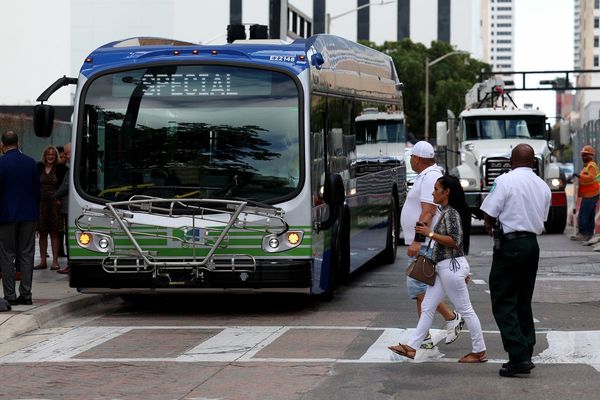
If you're the kind of car buyer who aims to break up with gasoline entirely, you probably haven't given the 2024 Lincoln Nautilus much thought. But there are very good reasons why you should, because the new SUV debuts an all-new software suite that has profound implications for the all-electric Ford or Lincoln you might buy someday—and it says a lot about where the Dearborn automaker is going in the years and decades to come.

Ford today released a bevy of details about its upcoming Ford and Lincoln Digital Experience, the all-new software suite on the just-released Nautilus that's coming soon to other vehicles in the near future. That operating system—created internally by Ford as part of a larger auto industry move to bring software development in-house—boasts unprecedented levels of speed, customization, in-car apps like YouTube and Amazon Prime Video, as well as a heavily revised degree of integration with Apple CarPlay and Android Auto.
Get Fully Charged
The software wars come to your car
Nearly every automaker is chasing in-car apps, downloads, gaming, streaming and more as cars become more and more automated—and as they see big revenue dollars from these downloads. But historically, the auto industry has lagged far behind the tech industry, so it's now scrambling to catch up and turn cars into the "smartphones on wheels" many have long predicted.
While the Nautilus can be had with a turbocharged gas engine or a hybrid powerplant, Ford's tech team is adamant that this system will inform future EVs.
"Easy-peasy," Brian Nash, a digital product line manager for Ford's Model e division, told InsideEVs at a media briefing last week. "We built [this platform] in a way that we can put it on anything we want. It's a very simple lift. That's one of the key pieces of this platform."
And in many ways, it feels more built for an electric future than one powered by gasoline.
Fast And Easy, Hopefully
Ford demonstrated the two versions of this system to journalists in Dearborn: a Lincoln-specific version currently available on the Nautilus, and an upcoming one for Ford vehicles. In case you've forgotten, the former can be had on a sweeping panoramic 48-inch display that runs the entire length of the dashboard.

Granted, that display doesn't have its own touch-based controls and is operated entirely through a slightly more conventional 11.1-inch central touchscreen. But it's still the Ford Motor Company's take on the "all screens, all the time" phenomenon that's seen on the Mercedes-Benz EQ Hyperscreen, Cadillac Celestiq and others. And on that screen, the name of the game is customization and ease of use.
After all, it's one thing to put an experimental, boundary-pushing software interface on a car from a startup whose customers will likely be early-adopter types; Ford has to design this sort of thing for everybody.
"If you follow J.D. Power's data around customer satisfaction with the in-vehicle experience, it's actually been declining over the last couple of years," said Zafar Razzacki, Ford's director of future product, EV digital experiences and services and a Google alum. "That's because of the complexity of technology inside of the vehicle. Customers are feeling overwhelmed and confused, so that's a key design principle that we're focused on: making sure that it's simple, easy to use, and customizable."

Ford says that translates into putting critical information like media, weather and fuel economy on the panoramic screen right in the driver's line of sight; the ability to swap apps around on the screen as easily as you would on your smartphone; driver profiles that allow each person's custom setup to load as soon as they get in the car (though for now, that's just the one car and not any Ford or Lincoln you get into); prioritizing voice controls via Google Assistant or Amazon Alexa, depending on preference; and real-time traffic data via Google Maps.
Speed is a big focus here too, Ford executives said. Knowing that customers are fed up with the comparatively sluggish infotainment systems in many vehicles—often due to lagging behind the tech industry and relying on outdated but proven chipsets—Ford is trying to up the ante here. This system is said to have 14 times faster graphics processing than the SYNC setup as well as eight times the storage.
Similarly, more features and upgrades are coming via over-the-air updates, something pioneered by Tesla that's now seen as key to the auto industry's tech-driven future.

"We know that smartphones set the bar in terms of responsiveness of customer experiences, and this is the system that raises that and delivers to that experience," said Hadi Saab, Ford's
director of product management for infotainment and cabin systems. "This is the fastest infotainment system that we've ever developed."
Stuff To Do While You're Parked, Too
And like much of the rest of the industry—including direct competitors like General Motors' Ultium EV platform—Ford is offering downloadable apps from Google Play like Spotify, Amazon Music and Audible.
Here, that includes in-car gaming and streaming, such as a Ford-exclusive version of the racing game Asphalt Nitro 2 that can be played with a Bluetooth game controller. Streaming via YouTube, Prime Video and the Vivaldi browser are also on tap, and Google Chrome is coming soon as well, complete with Bluetooth keyboard compatibility too.

Moreoever, more specific types of content—whether it be games or streaming—may come to Lincoln's big panoramic screen too. And it should look pretty good there as well. "This is the highest resolution display that we've ever offered on a Lincoln vehicle," Saab said. "It simulates the high end TVs that you have at home."
While streaming and gaming in the car is a relatively new thing and extremely novel to customers used to buying cars for horsepower and fuel economy, it helps to understand where the auto industry is going, and much of that has to do with EVs.
First and foremost, even Ford will admit that these features are being included to give people things to do while parked at fast-chargers—something still not as quick as filling up a gas-powered car. But really, a lot of it has to do with autonomous cars. The entire car industry is still chasing fully automated driving systems, and as it builds up to that, people will need something to do in the car if they aren't actively driving it. All of this feels like steps in that direction.
"I think we all just have to accept that that's an inevitability," Razzacki told InsideEVs. "There will come a day when we will be able to fully take our eyes and hands eyes off the road. How else are we going to use the vehicle during this time?"
He added, "whether that's productivity, whether that's enjoyment, whether that's just rest, we think there's a ton of opportunity to do all that."
More Coming Soon
These features are on the 2024 Lincoln Nautilus, which recently went on sale. The automaker did not specify which future Ford and Lincoln cars will get these systems, but said more details will be released in the coming weeks.
We do know these software features dovetail with Ford's future EV plans, which remain in progress despite up-and-down electric adoption in 2023. Indeed, a day after demonstrating this system to journalists, Ford announced it was reducing F-150 Lightning production to increase output of gas-powered trucks and SUVs. However, the automaker still has its next-generation all-electric T3 Truck in the cards, and a recent patent potentially revealed details about a ground-up modular EV platform possibly in development.
As a result, Ford officials stressed that this software suite is "only the beginning," and key to a future where winning could be more about electric range and tech features than mechanical ones. And Razzacki said that while the entire industry is racing toward similar goals with software services (and software revenues,) Ford has been aggressively moving these functions in-house rather than relying on scores of outside suppliers while it focuses on an easy user experience for people new to software-driven cars.
One thing that stands out, Razzacki said, "are our really close partnerships with Apple and Google and Amazon. While this is Ford's platform, and we want to make it a unique experience for us, we're also working very closely together with them," he said. 'We're learning from them. We're trying to get the best of Android in terms of a platform for us to develop on as well as really trying to meet the customer where they are."
Contact the author: patrick.george@insideevs.com







